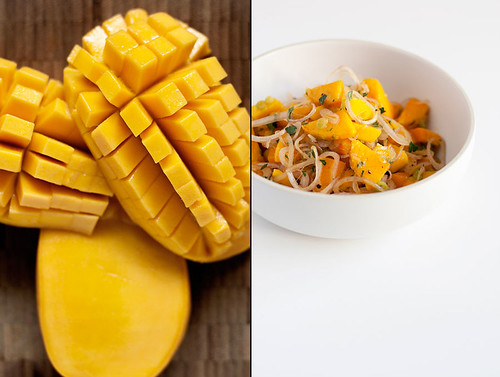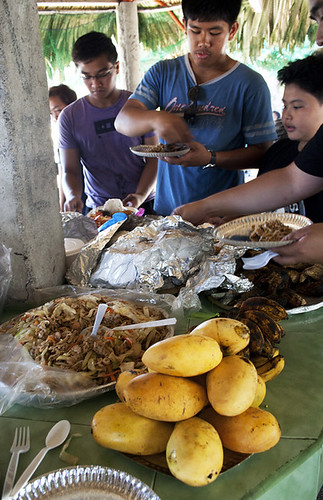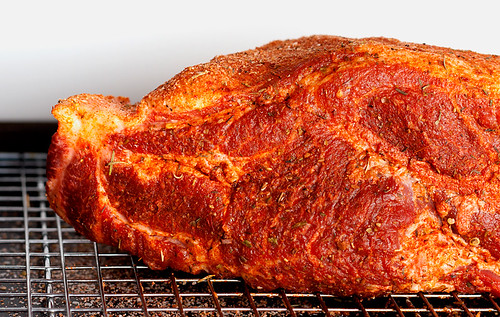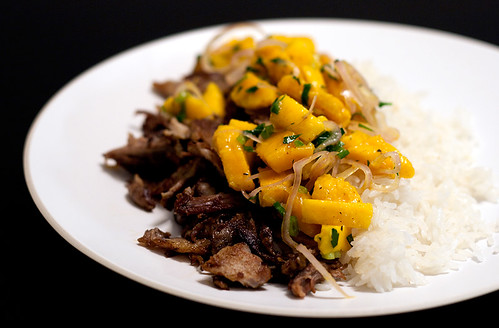There are plenty of reasons why one should eat seasonally. Without a doubt one of the main reasons is flavor. Take a mango for example, which, a few months ago, would not only cost you twice as much as it does today, but would also not shower you with the amazing sweetness that a perfectly ripe mango can offer. I adore mangoes. Probably due to the fact (ok, mythical fact) that I fell from the mango tree - which is where my mom told me I came from.
A few weeks ago, Ataulfo mangoes started appearing at our international farmer's market. Native to the Philippines and Mexico, they're smaller, bright yellow, luscious, and buttery. Unfortunately, they were all imported from Mexico, but alas, it's difficult to find these type of mangoes in the U.S. (mangoes grown in Florida are usually Tommy Atkins).
This same time last year, I was in the Philippines visiting the other half of my family for the first time since 1995. Sixteen years. My cousins who once were small enough for me to tote around on my hip were now sharing a beer with me at the dinner table.
I forgot a lot of things about the Philippines... the sights, the sounds, the smells... well, I may have purposely dismissed some of that from my memory.
I forgot, or maybe just never realized how good the food really was. Everything seemed new to me, except for my Lola's house... and the taste of a perfectly ripe mango.
Nothing beats the bang! thump, thump... thomp of a mango falling off of the tree and rolling down your roof... then bribing your little brother to climb up there and get it for you. That's right, they are so ripe that they fall off the tree. None of this picking it 2 weeks before it's ready so that it holds up through shipping and processing crap.
As I walked by the imported flats of little golden gems, I figured they wouldn't compare to their Filipino cousins. Trying to stay away from non-local produce as much as possible, I hesitated buying them - but I was craving them. I tossed a couple into my basket while David picked out a beautiful Berkshire pork shoulder butt.
We played around in the kitchen, brainstorming ideas for the mangoes and this massive hunk of pig. With this amount of meat (roughly 4lbs), we knew we could experiment on a good 3 or 4 diferent dishes, and at only $15, it was a steal. Pork shoulder butt is quite a fatty cut, which lends itself well to a moist heat cooking method. David braised the pork in the oven, and after 4 to 5 hours, we were greeted with a falling off the bone, beautifully fork-tender piece of meat, with a rich stock to go along with it.
The mangoes were surprisingly just as sweet and juicy as the Filipino mangoes I love so much. If the ones in the Philippines were easily falling from the trees this time last year, that must mean it's mango season in Mexico too.
So I am happily sharing this recipe. The meaty, richness of the pork balances perfectly with the sweetness of the mangoes and coconut rice, and leaves you with a spicy tingle from the shallots and red pepper.
Braised Pork Shoulder with Mango Salsa and Coconut Rice
For the Pork
1 pork shoulder butt, bone-in
1 quart of chicken stock (you can substitute vegetable stock)
1 whole yellow onion, cut into large slices
1 celery rib, cut into large pieces
2 medium-sized carrots, cut into large pieces
2 bay leaves
a few sprigs of fresh thyme and parsley
2 garlic cloves, smashed
1 whole yellow onion, cut into large slices
1 celery rib, cut into large pieces
2 medium-sized carrots, cut into large pieces
2 bay leaves
a few sprigs of fresh thyme and parsley
2 garlic cloves, smashed
Seasoning Mixture:
*This is proportional by weight, so based on the size of your meat, you can make more or less of this as needed, just follow the percentages.
50% kosher salt
25% freshly cracked black pepper
20% Spanish paprika
5% Herbes de Provence
The Night Before:
Pat the pork dry with a clean dish cloth or paper towel and rub liberally with the seasoning mixture. Let sit on a wire rack over a sheet pan, uncovered in the refrigerator for 24 hours or over night.
The Day Of:
Preheat oven to 325° Fahrenheit.
Place the pork shoulder into an oven-safe dish that is large enough to fit the meat with about 1/2 to 1 inch of space between the meat and the sides of the pot. Fill with the pot with the stock until the meat is about half-way submerged. Add the vegetables and aromatics to the pot. Place, covered into the oven.
*If your dish or pot doesn't have a lid, cover with parchment paper, then wrap aluminum foil over top to seal.
Set a timer, an hour or so at a time (so you don't forget about it!), and occasionally turn and baste the meat with the stock. The pork shoulder is done once the meat pulls away from the bone, or alternatively when a fork glides easily into the meat with no resistance, about 4-5 hours.
For the Coconut Rice
2 cups of jasmine rice
1 & 1/2 cups of coconut milk
1 & 1/2 cups of water
1 & 1/2 cups of coconut milk
1 & 1/2 cups of water
Bring 1 & 1/2 cups of coconut milk and 1 & 1/2 cups of water together to a boil in a medium pot. Once boiling, add the rice and stir once to make sure the rice doesn't stick to the bottom of the pot. Once it has returned to a boil, turn the heat to low and simmer, covered for 20 minutes. Remove from the heat and let rest, covered, until you finish assembling the rest of the dish.
For the Mango Salsa
2-3 ataulfo mangoes
1 large shallot
1-2 green onions, sliced
1 bunch of cilantro (you can substitute parsley)
2 teaspoons crushed red pepper flakes
2 teaspoons whole coriander
2 teaspoons lemon or lime juice
salt and pepper, to taste
1 large shallot
1-2 green onions, sliced
1 bunch of cilantro (you can substitute parsley)
2 teaspoons crushed red pepper flakes
2 teaspoons whole coriander
2 teaspoons lemon or lime juice
salt and pepper, to taste
Peel and thinly slice one shallot crosswise, so that you create small rings. Place into a bowl of cold water and let soak for a few minutes to reduce the sharpness of the shallot.
Wash the mangoes and cut into small cubes.
*Even though this video shows them cutting Tommy Atkins mangoes, which are large than Ataulfo mangoes, the same principles apply when cutting a mango.
Place the diced mango into a medium-sized bowl. Add the sliced green onions.
Wash the cilantro thoroughly, and pick the leaves from a few sprigs. Gently pat the leaves dry with a paper towel or clean dish cloth. Give the leaves a rough chop, and place in the bowl with the mango.
Remove the sliced shallot from the water and place onto a dry paper towel or dish cloth, and pat dry. Once dry, place into the bowl with the mango.
Using a mortar and pestle, or a spice grinder, grind together the red pepper flakes and whole coriander until completely ground.
*I used a small mesh strainer to weed out the coriander husks and any large pieces. If using a spice grinder, this may not be necessary.
Place into the bowl with the mangoes and gently toss everything together with a spoon. Salt and pepper to taste.
*I used a small mesh strainer to weed out the coriander husks and any large pieces. If using a spice grinder, this may not be necessary.
Place into the bowl with the mangoes and gently toss everything together with a spoon. Salt and pepper to taste.
To Finish
Heat a couple tablespoons of the rendered pork fat (this can be skimmed off the top of the stock) in a large saute pan over medium-high heat. Shred 4 portions worth of the pork shoulder into the pan, and toss occasionally, letting the outsides get browned and crispy.
Place on a plate along side of the coconut rice, and top with the mango salsa. Serves 4.









That was the perfect combo of sweet+tart+salty+fatty, and it still manages to not feel as if you are gorging on something unhealthy.
ReplyDeleteIf you have any other mango recipes you want to try, you know I am the first volunteer to be your taste tester.
:) You're my #1 taste-tester!
DeleteTechnology reviews and updates
ReplyDeleteTechnology reviews and updates
Technology reviews and updates
Technology reviews and updates
Technology reviews and updates